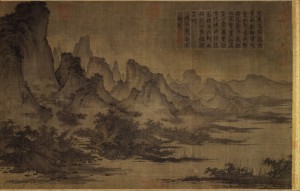夏山
这是一幅屈鼎的水墨画叫“夏山”。 它被用墨绘在丝绸卷轴上. 画中有很多山, 从右边到左边,山变得越来越大。 一江春水流向画的右侧, 因为河水从高的地方流到低的地方 。 这张画使用了灰色和黑色的色调。画的左边的颜色变深。在山脚下有一座寺庙。
屈鼎是11世纪一个北宋的人。他是一个有名的艺术家 “燕文贵”的学生 。 这幅画有旧中国风格, 它承载着深沉静的情绪 ,我真的很喜欢。 我选择了这张画,因为这是他唯一仅存的画,所以是有一点神秘的。
我很想亲眼看到这样的风景。 树木、山脉、河流营造出温馨的环境。 如果我在这幅画里,我会走在树林里,在河里游泳。然后, 我会去参观寺庙,看看艺术家的理念。
This is an ink painting called “Summer Mountains” by Qu Ding 屈鼎. It was painted using ink on a silk scroll. The painting has many mountains that increase in height towards the left side. A river flows across the painting, and it probably is flowing towards the right side since rivers flow from higher to lower ground. The painting uses shades of brown and black. These colours darken towards the left side of the painting. At the foot of the mountains sits a temple.
Qu Ding was of the Northern Song Dynasty from the 11th century. He is a student of the famous artist Yan Wengui. The painting is in the old Chinese style that has a strong message of stillness that I find really interesting. I chose this piece because it is his only last remaining work, and so has an air of mystery around it.
It would be great to see a landscape like this with my own eyes. The trees, mountains and water come together to create a very welcoming atmosphere. If I were in this painting, I would walk around and even swim in the river. I would then visit the temple and maybe witness the same philosophy that inspired the artist to paint this painting.

